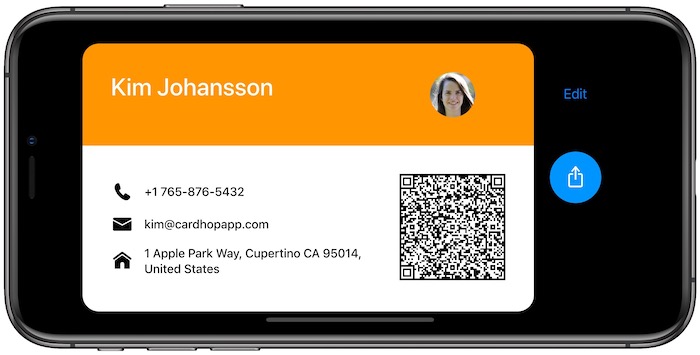

Need to delete some data, like an old phone number? Invoke Cardhop and type “cook delete phone.” Cardhop even colorizes the word “delete” so you know it’s a command and not data. Notice that I put “work” at the start to indicate this is a work address “home” and “other” are also possibilities, or you can just leave that word out to default to a home address. Then enter “work 1 Infinite Loop Cupertino CA 95014” and Cardhop adds it as soon as you press Return. Once Cardhop has selected the right contact, you can add Tim Cook’s address just by typing it. If you have multiple people named Tim in your contacts, you might need to type “tim co” to get the right contact, or you could just It’s just too easy to find the person you want with a few keystrokes.

That’s all there is to a search, which is why I don’t think you’ll want to browse through all contacts or restrict searches to groups in most cases. Invoke Cardhop, and start typing a portion of his name (first or last, it doesn’t matter). Want to add an address? First you have to find Tim Cook’s contact card. Press Return or click Add Contact and you’re done. You can even copy and paste all that information into Cardhop, and it will work similarly. Enter “Tim Cook Apple 40” and Cardhop immediately starts creating a new card and filling it out with the name, company name, email address, Twitter handle, and phone number. Press the hotkey you’ve defined to bring up Cardhop and then start typing. That might sound like a throwback to command-line tools, but actual usage is far more fluid and intuitive than the command line.Īdding, Searching, and Editing - For instance, imagine you want to add a contact for your new friend Tim Cook. That’s because Flexibits built Cardhop around its natural language parser, so even though you can click buttons and choose menu items to run Cardhop, it’s designed so that you can type at it.

Again, I doubt you’ll want to do this much. Similarly, you can expand the window to see contact groups, and click one to restrict the search results to people in that group. You can click All Contacts at the bottom to see everyone, but realistically, you won’t want to do that most of the time. Initially, Cardhop shows you the people whose birthdays are coming up shortly (I turned this off by deselecting View > Show Birthdays), followed by people whose contact info you’ve worked with recently in Cardhop. However, you can drag its popover off the menu bar to turn it into a standalone window that remains visible when you move to another app. By default, it appears as a popover when you invoke it and disappears when you switch away from it. Cardhop relies on exactly the same system-level contact database that Contacts and Bus圜ontacts use, but how you add, edit, and use contacts is rather different.įirst off, Cardhop is an attractive menu-bar app with light and dark modes. It’s all stuff that any database can do, but until Cardhop, interacting with a contact manager wasn’t much different than using FileMaker. Create a record, edit fields, perform searches, etc. Part of the problem with contact management is that it’s basically database work.
#BUSYCONTACTS VS CARDHOP MAC#
BusyMac did a good job at creating a better monolithic contacts app with Bus圜ontacts back several years ago (see “ Bus圜ontacts Turbo Charges Mac Contact Management,” 17 March 2015), but Flexibits, makers of Fantastical, have now introduced a completely different take on contact management: Cardhop. It’s just a bad app, with terrible use of space and a clumsy, modal user experience. I hated Apple’s Contacts app even when it was called Address Book.
#BUSYCONTACTS VS CARDHOP FREE#
#1621: Apple Q3 2022 financials, Slack's new free plan restrictions, which OS features do you use?.#1622: OS feature survey results, Continuity Camera webcam preview, OWC miniStack STX.
#BUSYCONTACTS VS CARDHOP HOW TO#
#1623: How to turn off YouTube's PiP, use AirPlay to Mac, and securely erase Mac drives.


 0 kommentar(er)
0 kommentar(er)
